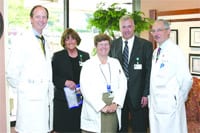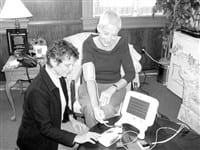A Heart for Change Berkshire County’s Heart Disease and Stroke Patients Are Living Longer
According to Dr. Gray Ellrodt, an 85{06cf2b9696b159f874511d23dbc893eb1ac83014175ed30550cfff22781411e5} success rate may be sufficient to win an award, but it’s not good enough.
He was speaking about Berkshire Health Systems’ recent recognition by the American Heart Association (AHA), which honored BHS for spearheading a marked reduction across Berkshire County in death rates from heart disease.
In fact, said Ellrodt, chairman of the Berkshire Medical Center Department of Medicine, the county now leads the state in decreasing mortality rates for cardiovascular diseases, coronary artery disease, heart failure, and stroke.
Specifically, the award recognizes that BHS has maintained a high level of performance, as defined by the AHA’s Get with the Guidelines program, in treating patients with these conditions. Honored hospitals need to adhere to those guidelines at least 85{06cf2b9696b159f874511d23dbc893eb1ac83014175ed30550cfff22781411e5} of the time.
One of the ways Berkshire achieved that goal, Ellrodt said, was by changing the entire culture of the hospital — and it’s an ongoing task.
“The culture change is the most challenging piece of all,” Ellrodt said. “You have to get from, ‘it’s OK if we’re at 85{06cf2b9696b159f874511d23dbc893eb1ac83014175ed30550cfff22781411e5} because that gets us an award,’ to where the only thing that’s acceptable is, when there’s an opportunity to provide an intervention to a patient, be it a drug or counseling or something else, we do it — 100{06cf2b9696b159f874511d23dbc893eb1ac83014175ed30550cfff22781411e5} of the time. And if we miss it, we take it intensely personally. We don’t point fingers and blame each other, but we examine how we can get it right.”
The Healthcare News spoke with Ellrodt this month to discuss what has gone right in cardiovascular treatment — and how BHS can continue saving and prolonging lives in Berkshire County.
Getting with the Program
Get with the Guidelines is the AHA’s hospital-based quality improvement program, designed to close treatment gaps in cardiovascular disease. The collaborative effort supplies physicians and health care providers with materials, information, and tools to comply with the AHA’s treatment guidelines.
The program not only encompasses inpatient treatment, but has a strong teaching component, whereby patients are discharged with appropriate medication prescriptions and effective risk-modification counseling — in other words, understanding what lifestyle changes they need to undertake in order to increase their chances at a healthy life.
According to the AHA, the program could save more than 80,000 people annually if 75{06cf2b9696b159f874511d23dbc893eb1ac83014175ed30550cfff22781411e5} of the eligible patients discharged from participating hospitals are treated at an 85{06cf2b9696b159f874511d23dbc893eb1ac83014175ed30550cfff22781411e5} compliance rate with the association’s guidelines.
“Basically, the recognition is given to institutions that have maintained a high level of performance in evidence-based interventions for patients with heart attack, stroke, and heart failure,” Ellrodt said. Of the 1,212 hospitals participating in the AHA program nationwide, Berkshire Medical Center currently leads all facilities with seven overall performance achievement awards.
According to Ellrodt, besides the actual bedside work of doctors, nurses, and other medical staff, Berkshire Health Systems has achieved its success in lowering mortality and morbidity rates in three ways: leadership, culture change, and efficiency of the entire system.
“When I say leadership, it’s not just physicians, nurses, and case managers,” he told The Healthcare News. “It’s leadership from on high. It takes resources to be good at this, and if our leaders don’t buy into the program — by providing the resources needed to be successful, not just cheerleading — we won’t be successful.”
Ellrodt said that successful hospitals tend to share ideas with each other, and these interactions have fortified his belief in the importance of administrators who are dedicated to constant improvements in care.
“When you start talking to organizations that are successful, the fundamental piece you’ll find is significant commitment from leadership,” he said.
As for the culture change that Ellrodt has observed, he said it’s a mindset that should be prevalent in all hospitals, noting that the average hospital adheres to the AHA Get with the Guidelines standards just 55{06cf2b9696b159f874511d23dbc893eb1ac83014175ed30550cfff22781411e5} of the time.
“That’s frightening, I know, but that’s the truth,” he said. Still, he noted, even reaching a 100{06cf2b9696b159f874511d23dbc893eb1ac83014175ed30550cfff22781411e5} standard isn’t good enough if the hospital doesn’t continually assess its patient interventions, stay diligent, and strive to improve. “There’s only one place to go from 100{06cf2b9696b159f874511d23dbc893eb1ac83014175ed30550cfff22781411e5},” he said, “and it’s not 101{06cf2b9696b159f874511d23dbc893eb1ac83014175ed30550cfff22781411e5}.”
Excellence for Sale
Ellrodt was quick to note that the AHA gives its performance-achievement awards in two categories: annual and sustained. Annual award recipients have maintained the high performance level for one year, while hospitals cited with the sustained award have maintained that level for at least two years, if not longer. Berkshire reached the sustained status in its work with coronary artery disease and stroke patients.
“That’s what the program strives for, and that’s what our community and our patients expect. They don’t expect a good month or three months,” Ellrodt said, comparing short-term performance to a weekend sale at a retail store.
“A sale is great, but you want your customers to know that, day in and day out, they can get high-quality products at a good cost. What the American Heart Association really stresses in this program isn’t excellent performance for a quarter. They want you to keep it going as long as the program is in existence.”
After all, Ellrodt said, the AHA’s goal is to reduce cardiovascular mortality rates 25{06cf2b9696b159f874511d23dbc893eb1ac83014175ed30550cfff22781411e5} by 2010, and it’s a goal the hospital shares.
”It’s something that happens one hospital at a time, one patient at a time,” he said. And if the numbers are to be believed, far more patients than one are already reaping the benefits.



